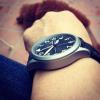This is the first installment of what I hope will be a series of updates on my experience at the York Time Institute.
In Lesson 1 of the Chicago School of Watchmaking's Master Watchmaking Shop Training and Job Guides, Thomas B. Sweazey says,
The second sentence of this quote spells out the ethos of the York Time Institute as expressed by its director Daniel Neid. "Dan" is firmly committed to the idea that his students will not only be able to make repairs from stock parts but also, if necessary, be able to make parts when necessary. Not only that he will also be able to understand all the different mechanisms that go to make up the complete watch--including but not restricted to casemaking.
My experience so far is that Mr. Neid not only has the knowledge but the tools to put paid to this claim--we shall see. I hope to be able to provide vignettes of how much I will be able to learn and put to practice.
For now I am totally amazed--one might say overwhelmed--by not only Dans knowledge of current practices but his avid knowledge of the history of the techniques and tool of this honorable and difficult craft. He has an absolutely amazing array of tools, many of them very rare and practically unattainable. I spent the better part of yesterday afternoon inspecting a multitude of watchmakers lathes; ranging from small bow-driven lathes to modern motor driven ones. Add in a huge number of examples of all the tools mentioned in the Chicago School's manual. He not only has examples of modern tools but their predecessors that date back well into the 19th century. I am looking forward to the chance to try them--especially the bow and treadle-driven lathes.
We spent several hours today examining measuring devices, many of them factory pieces once used at places like Hamilton, Waltham and Bulova factories. It is amazing how many kinds of devices have been developed to perform the many types of measurements required for watchmaking. Again, I was overwhelmed and am looking forward to trying some of them.
Dan has a good rationale for spending a good amount of time inspecting the tools of the trade: he says it will be invaluable for being able to identify tools at various kinds of sales such as estate sales, yard sales (yes many of his tools have come from such sources). The student (like me) will be able to sometimes get great bargains by being to identify a tool that perhaps its owner doesn't recognize. The other students confirm that they have, in fact, put their knowledge to acquiring lots of interesting pieces themselves.
We work in close quarters in a shop chock-a-block full of watchmaking tools and a huge inventory of parts. I once spent some time at sea on a nuclear submarine every facet of which serves some importance towards its mission. It was like living inside a machine. I get this same feeling at the institute. The close quarters serves to create an espirit de corps that I hope I will be able to share someday. The students are inculcate with sense of being a "breed apart" from the ordinary person and take pride in their work. It's also informal but serious and sometimes not so serious. Dan seems to be a good psychologist recognizing emotional ups and downs that can accompany success and defeat. The former receives praise but a gentle reminder to keep focused and not to let them swell the head. The latter is met with the reassurance that our foulups and fumbles are a necessary part of the learning experience; the even experienced students and masters loose parts and break things--underscoring the need to be able to make what one does not have or has lost or destoryed. When we get into a dudgeon over repeated failures Dan says, "Go take a break and don't let it get under your skin." Because it is through failures and even catastrophes that one really learns. One must develop patience and take the time to get the task right.
He pays attention to how our tools are organized by task and frequency of use. He helps his students acquire their tools from the least expensive sources--though considerable expanses will be incurred event the. Though students are encouraged try out his many tools and devices to further direct acquisitions by the student. I just bought a nice lathe with complete sets collets. I will spend some of my time restoring it to mint condition. And its not jjust Dan, the other students are willing pitch in by selling the beginner some ot their surplus tool at very reasonable prices. I too donated to the Institute several of my supplies to the general pool can be of help to all students.
We are constantly being giving spot tests to see what we've learned. For now my tests are ones of recognition.
I'm getting tired to I'll cut this short by showing you a couple pictures of my bench. It's an old bench as you can see with a place for a treadle on the left. I love the feeling that I am working where generations of watchmakers worked before me. My I do them honor and justice. My bench is the one in the middle with my laptop on it. Today they are indispensable for research.




